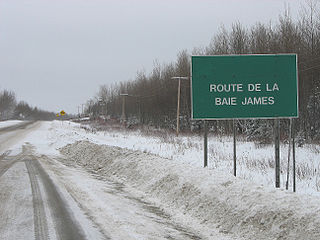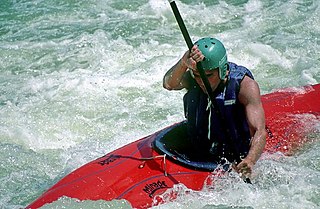
James Bay is a large body of water on the southern end of Hudson Bay in Canada. Both bodies of water extend from the Arctic Ocean, of which James Bay is the southernmost part. It borders the provinces of Quebec and Ontario. Islands within the bay are part of the Nunavut territory.

Nunavik comprises the northern third of the province of Quebec, Canada in Kativik, part of the Nord-du-Québec region. Covering a land area of 443,684.71 km2 (171,307.62 sq mi) north of the 55th parallel, it is the homeland of the Inuit of Quebec. Almost all of the 12,090 inhabitants of the region, of whom 90% are Inuit, live in fourteen northern villages on the coast of Nunavik and in the Cree reserved land (TC) of Whapmagoostui, near the northern village of Kuujjuarapik.

Nord-du-Québec is the largest, but the least populous, of the seventeen administrative regions of Quebec, Canada. With nearly 750,000 square kilometres (290,000 sq mi) of land area, and very extensive lakes and rivers, it covers much of the Labrador Peninsula and about 55% of the total land surface area of Quebec, while containing a little more than 0.5% of the population.

The Kativik Regional Government encompasses most of the Nunavik region of Quebec. Nunavik is the northern half of the Nord-du-Québec administrative region and includes all the territory north of the 55th parallel. The administrative capital is Kuujjuaq, on the Koksoak River, about 50 kilometres inland from the southern end of the Ungava Bay.

The James Bay Project refers to the construction by state-owned utility Hydro-Québec of a series of hydroelectric power stations on the La Grande River in northwestern Quebec, Canada, and the diversion of neighbouring rivers into the La Grande watershed. It is located between James Bay to the west and Labrador to the east and its waters flow from the Laurentian Plateau of the Canadian Shield. The project covers an area of the size of the State of New York and is one of the largest hydroelectric systems in the world. It has cost upwards of US$20 billion to build and has an installed generating capacity of 16,527 megawatts. If fully expanded to include all of the original planned dams, as well as the additional James Bay II projects, the system would generate a total of 27,000 MW, making it the largest hydroelectric system in the world.
Indigenous peoples in Quebec total 11 distinct ethnic groups. The 10 First Nations and the Inuit communities number 141,915 people and account for approximately 2% of the population of Quebec, Canada.
Matthew Coon Come is a Canadian politician and activist of Cree descent. He was National Chief of the Assembly of First Nations from 2000 to 2003.

Waskaganish is a Cree community of over 2,200 people at the mouth of the Rupert River on the south-east shore of James Bay in Northern Quebec, Canada. Waskaganish is part of the territory referred to as "Eeyou Istchee" encompassing the traditional territories of Cree people in the James Bay regions of what is now Northern Quebec and Ontario.
The James Bay and Northern Quebec Agreement is an Aboriginal land claim settlement, approved in 1975 by the Cree and Inuit of northern Quebec, and later slightly modified in 1978 by the Northeastern Quebec Agreement, through which Quebec's Naskapi First Nation joined the treaty. The agreement covers economic development and property issues in northern Quebec, as well as establishing a number of cultural, social and governmental institutions for Indigenous people who are members of the communities involved in the treaties.

Chisasibi is a village on the eastern shore of James Bay, in the Eeyou Istchee TE in northern Quebec, Canada. It is situated on the south shore of La Grande River, less than 10 km (6.2 mi) from the river's mouth. Chisasibi is one of nine Cree villages in the region, and is a member of the Grand Council of the Crees of Quebec. The territory surrounding Chisasibi is part of the Eeyou Istchee James Bay Territory, of which parts are jointly managed by the municipalities of the Jamésie TE and the Cree Regional Authority of the Eeyou Istchee TE.

Whapmagoostui is the northernmost Cree village in Quebec, Canada, located at the mouth of the Great Whale River on the coast of Hudson Bay in Nunavik. About 906 Cree with about 650 Inuit, living in the neighbouring village of Kuujjuarapik. The community is only accessible by air and, in late summer, by boat. Whapmagoostui is about 250 km (160 mi) north of the nearest Cree village, Chisasibi.

Kuujjuarapik is the southernmost northern village at the mouth of the Great Whale River on the coast of Hudson Bay in Nunavik, Quebec, Canada. Almost 1000 people, mostly Cree, live in the adjacent village of Whapmagoostui. The community is only accessible by air, Kuujjuarapik Airport and, in late summer, by boat. The nearest Inuit village is Umiujaq, about 160 km (99 mi) north-northwest of Kuujjuarapik. The police services in Kuujjuaraapik are provided by the Kativik Regional Police Force.

The James Bay Road is a remote wilderness highway winding its way through the Canadian Shield in northwestern Quebec and reaches into the James Bay region. It starts in Matagami as an extension of Route 109 and ends at Radisson. The road is fully paved, well maintained, and plowed during the winter. It was originally constructed to carry loads of 300 tons, and has mostly gentle curves and hills with wide shoulders. The road is maintained by the Eeyou Istchee James Bay Regional Government. Connecting to other routes such as the Trans-Taiga Road and the Route du Nord, the highway draws tourists interested in reaching the remote wilderness surrounding James Bay, part of Hudson Bay.
Wemindji is a small Cree community on the east coast of James Bay at the mouth of the Maquatua River in Quebec, Canada. Its legal name is the Cree Nation of Wemindji. Wemindji is a part of the Abitibi-Baie-James-Nunavik-Eeyou district which is presented by NDP [Romeo Saganash]. The community has a population of approximately 1400 people. Around 1600 are affiliated to the Cree Nation of Wemindji and around 200 do not reside on the territory of Wemindji.
Lake Bienville is a lake in western central Quebec in Canada. The lake was named after Jean-Baptiste Le Moyne de Bienville, the younger brother of Sieur d'Iberville. The lake has several outlets, draining both east into Ungava Bay and west into Little Whale River, and into Great Whale River, which flows through this lake on its way to Hudson Bay.
The Agreement Respecting a New Relationship Between the Cree Nation and the Government of Quebec is an agreement between the Government of Quebec, Canada, and the Grand Council of the Crees. It was signed on February 7, 2002 in Waskaganish, Jamésie, Quebec, after decades of court battles between the Cree and the Government of Quebec. The name was inspired by the 1701 Great Peace of Montreal, also known as "La Paix des Braves".
The James Bay Cree hydroelectric conflict refers to the resistance by James Bay Cree to the James Bay Hydroelectric Project and the Quebec Government, beginning in 1971.

The Grand Council of the Crees or the GCC(EI), is the political body that represents the about 18,000 Crees or "Eeyou" of the territory called Eeyou Istchee in the James Bay and Nunavik regions of Northern Quebec, Canada. The Grand Council has twenty members: a Grand Chief and Deputy-Grand Chief elected at large by the Cree people, the Chiefs elected by each of the ten communities, and one other representative from each community.
Michael Posluns is a journalist and researcher in Canada. While a student at Carleton University, Posluns got involved in social justice issues, later joining the Company of Young Canadians. He went to Akwesasne where he worked with Rarihokwats and Ernie Benedict on publishing Akewsasne Notes, a local newspaper that ran from 1969-1996. He also became a self-trained court worker, assisting locals to navigate the legal system. In the mid-1970s, he served as a parliamentary adviser to the National Indian Brotherhood, working with George Manual. He also worked with the Dene Nation and others on governance, land claims, mercury poisoning and other issues. Posluns completed a PhD at York University in 2002 and his dissertation is entitled The Public Emergence of the Vocabulary of First Nations Self-Government. He is the author of numerous other articles and books and he is co-author with George Manuel of 'The Fourth World: An Indian Reality' (1974) and with David Nahwegahbow and Douglas Sanders of 'The First Nations and the Crown: A Study in Trust Relationships' (1983). Posluns is an important figure in raising the profile of indigenous rights in Canada. He worked closely with George Manuel to advance self-government and indigenous political rights and their work had significant impact on the work of future political actors. In speaking to The Globe and Mail in 2013 Posluns cited some of his early advocacy work in the 1970s involved changing the language the government used to refer to indigenous peoples. For example members of Canadian parliament would refer to activist Kahnitenata Horn as a "Mohawk princess," demonstrating an ignorance of the democratic governance structures of the Haudenosaunee Confederacy. Posluns continues to advocate on issues related to governance and challenging myths and problematic language related to indigenous peoples of Canada.












